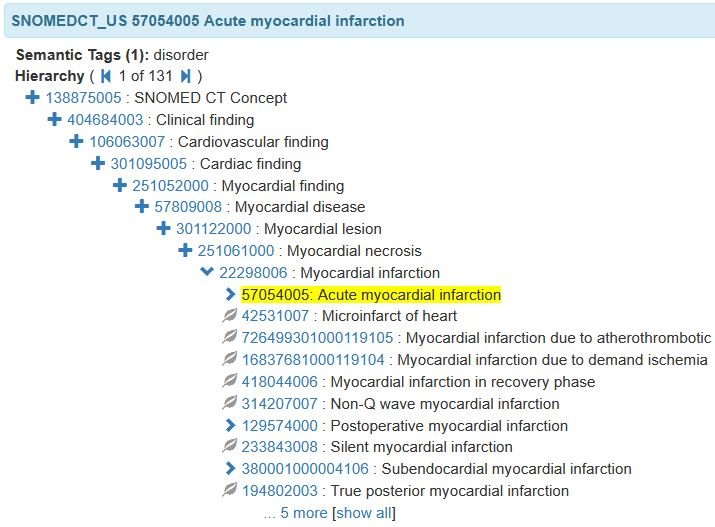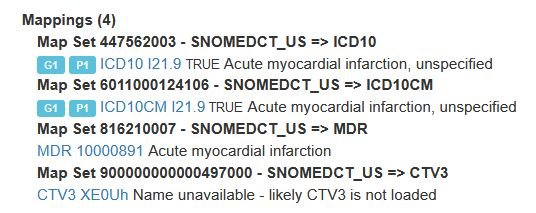What Is Mapping In Terminology?
Mapping is a key component in healthcare terminology. It facilitates the identification of one or more concepts in one terminology based on a concept in another terminology. In this series, WCI will answer the most basic questions regarding mapping. In the next article in the series Advanced Terminology Mapping Examples, we provide answer more advanced questions. That article will also provide examples of these basic concepts.
What’s the Purpose of Terminology Mapping?
A terminology mapping is used to translate terminologies and classifications from one system to another for a particular use case. Mappings make it easier to transmit and re-use data across different healthcare systems and for different purposes.
How Is Mapping Used in Healthcare?
Terminology mapping plays an important role in the healthcare industry by ensuring the interoperability of data exchanges between a wide range of clinical systems. By actively creating links between different clinical terminologies it enables patient data to be exchanged accurately and consistently between different systems, even when those systems use different terminologies.
Additionally, terminology mappings can allow data to be reused for different purposes than it was originally intended. For example, patient data can be mapped to a billing coding system to allow for reimbursement.
Terminology maps are used in a variety of healthcare applications, including electronic health records (EHRs), health information exchanges (HIEs), and clinical decision support systems (CDSSs).
What Are the Benefits of Terminology Mapping?
A terminology map improves data interoperability, enables secondary use of healthcare data, reduces errors, and supports more accurate and consistent reporting and analysis.
Where Can I View Some Maps Right Now?
NLM Value Set Authority Center (VSAC): The VSAC is a service provided by the National Library of Medicine (NLM) that provides access to value sets and mapping resources for various code systems, including SNOMED CT, ICD-10-CM, and LOINC. You can view and download maps between different code systems and terminologies from the VSAC website.
SNOMED International Mapping Tool: SNOMED International provides a mapping tool that allows users to view and search for maps between SNOMED CT and other code systems, such as ICD-10 and CPT. You can access the mapping tool on the SNOMED International website.
What can be mapped?
Mappings are created based on a specified use case. You would not want to map a procedure terminology to a terminology that focuses on clinical findings. For your mapping to be successfully implemented it has to be built for a specific purpose. It is important to determine the scope of the mapping for both terminologies to be mapped.
For example, a map between SNOMED CT and ICD-10-CM might be able to link the concept "Type 2 diabetes mellitus" to the ICD-10 code "E11.9" for "Type 2 diabetes mellitus without complications".
What cannot be mapped?
Concepts that are unique to one code system or terminology and do not have an equivalent concept in another system typically cannot be mapped. Additionally, concepts that are too complex or ambiguous to be accurately mapped between different systems or terminologies are also left as unmappable.
Concepts that have different levels of granularity or specificity in different code systems or terminologies.
For example, a map between SNOMED CT and ICD-10 may not be able to accurately map the concept "No evidence of recurrence of cancer" to an ICD-10 code, as ICD-10 does not have a code to represent this meaning.
Examples Of SNOMED CT Maps and Integrations
SNOMED CT to ICD-10-CM Mapping
This map translates SNOMED CT codes into ICD-10-CM codes to support reimbursement and statistical use cases.
This collaboration between SNOMED International and Regenstrief will allow for the SNOMED CT representation of LOINC as an extension of SNOMED CT.
SNOMED CT and RxNorm
SNOMED CT is one of the sources contained within RxNorm.
SNOMED CT to CPT mapping: This map enables the translation of SNOMED CT codes into Current Procedural Terminology (CPT) codes, which are used for coding medical procedures.
SNOMED CT to ICD-11 mapping: This map enables the translation of SNOMED CT codes into ICD-11 codes, which are the latest version of the International Classification of Diseases (ICD) standard.
Basics – What is a Map?
A terminology map or mapping refers to the process of translating concepts from one terminology or code system to another.
Terminology mapping helps improve interoperability by ensuring clinical data that is recorded with different terminologies may be consistently transformed and interpreted between different clinical systems.
It can also be used to support secondary uses of clinical data, like research, by providing a way to compare data from different sources. This goes a long way toward improving patient care as every clinician in a patient’s care team has access to the most up-to-date patient information.
Maps are typically stored as part of the server's metadata, along with other information about the terminologies and concepts included in the server. You can search for and view mappings between different terminologies. You can use these mappings to ensure that their clinical documentation and data exchange is accurate and consistent.
What are the attributes of a map?
Source/Target
Cardinality/Direction
Simple/Complex Types
What is a source terminology?
Mappings are directional and created from one terminology (the source) to another terminology (the target). The purpose of the mapping is to represent a given concept from the source terminology to a representative concept(s) in the target terminology.
What is a target terminology?
Mappings are directional and created from one terminology (the source) to another terminology (the target). The target terminology is the destination of the mapping and is not always an exact representation of the source concept. Exact mappings are preferred but not always possible as the semantics of both terminologies may not align perfectly.
What Are the Different Cardinalities Used in Terminology Mappings?
There are several different cardinality types of terminology maps, including one-to-one mapping, one-to-many mapping, and many-to-one mapping.
One-to-One Mapping
This type of map permits defining a single equivalent concept in the target for a given single concept in the source. Note: Given mappings are uni-directional, a One-to-One Mapping in a given direction does not mean that the two concepts are equivalent in the other direction.
One-to-Many Mapping
This type of map permits defining one or more equivalent concepts in the target for a given single concept in the source.
One-to-None Mapping or No Mapping
This occurs when a concept in a source terminology does not map to any concepts in a target terminology. These mappings are represented to ensure the complete scope of concepts in the source terminology are represented in the mapping.
Many-to-One Mapping
This type of mapping occurs when multiple concepts in a source terminology map to the same concept in a target terminology due to no exact representation existing in the target.
Mapping Types
Mappings are sometimes categories as being one of two types: Simple or Complex.
Simple Map Type
A simple mapping would be where one concept in a terminology maps to a single or combination of codes in the target terminology but doesn’t require the processing of any manual or automated rules. For example: SNOMED CT® Orphanet Map
This type of mapping is also created by organizations that are trying to represent their local source terminology within a standard target terminology.
Complex Map Type
Complex, sometimes called rules based mapping requires processing of either textual or automated rules to determine the target code(s). For example: SNOMED CT to ICD—10-CM map. While these types of mapping can include simple mappings the inclusion of these rules based mappings required a more complicated implementation.
Authoring, Publishing & Distribution
The goal of a mapping project is to map content to fulfill a use case (when a map from a source-to-target terminology they require isn’t available) or update an existing map which they are responsible for. This effort was performed historically in spreadsheets. However, the industry has evolved to using dedicated mapping tools to greatly improve performance and accuracy in a collaborative experience as offered by the WCI Mapping Tool.
What Organization is Responsible for Creating and Updating Maps?
Official standard mappings are typically created by the standards organizations or National Release Centers that are responsible for maintaining either the source or target terminologies. They are also sometimes created or modified by organizations that need to build or modify them for a specific use case.
What is the process for publishing maps?
Once the map is authored and validated, the organization will typically publish it thereby providing it with an official map version. It will then distribute it to its stakeholders and hosting organizations (like in UMLS).
What are the contents of a published mapping file?
The contents of a published mapping file can vary depending on the organization that creates the mapping. This can be as simple as a spreadsheet or as complex as a SNOMED CT RF2 file.
What is Versioning?
Both the source and target terminologies typically have different schedules for the release of new versions. When each of these terminologies is updated it could necessitate the addition or change of existing mappings.
The versioning of maps
Well formed terminologies and their mappings will be versioned and track changes at a granular level to allow for easier implementation of updates. Any change to the terminology mapping should be tracked and identified so that implementers can approve and update their implementation. If local changes to standard mappings have been done any updates will need to be identified and made.
What initiates a new version?
Source terminology updates: Any new or changed concepts in the source terminology will need to be added or reviewed.
Target terminology updates: Any new or retired concepts in the target terminology could potentially require a change to existing mappings.
Updating the map in general i.e., expanding the coverage: This is typically an issue when mappings are being developed and not complete. Some organizations may choose to release mappings as they are completed and not wait until the scope of content of the map is completely mapped.
Things to Consider Before Implementing
When implementing a terminology map, you need to consider some important factors such as the scope and complexity of the mapping. Depending on the complexity of the mapping, you should also take into account the availability of expertise and resources that can be used to facilitate the implementation of the mapping. Since not all mappings are equivalent one-to-one mappings you will need to determine the ability to manually or automatically process mapping rules to determine the appropriate code. Due to this you will need to factor in the potential impact on existing workflows and processes. Then make sure to build in time for the transition.
Mapping Challenges
Terminology mapping can be complex and time-consuming, especially when dealing with complex clinical concepts that may not have a direct equivalent in the target terminology.
For example, the SNOMED CT concept 10821131000119109 |Open fracture of left fibula| requires additional information that may exist elsewhere to map to an appropriate ICD-10-CM Code. This single SNOMED CT concept could map to 16 different codes depending on additional information that could be stored elsewhere in the clinical record.
Expertise Required:
Terminology mapping often requires expertise in both the source and target terminologies. A deep understanding of the clinical concepts being mapped in both terminologies is essential to ensure a complete and accurate mapping.
Questions, ideas or concerns regarding your mapping capabilities? Contact us today and we are available to help your organization.


